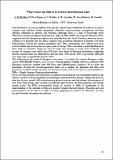Por favor, use este identificador para citar o enlazar a este item:
http://hdl.handle.net/10261/166088COMPARTIR / EXPORTAR:
 SHARE
BASE SHARE
BASE
|
|
| Visualizar otros formatos: MARC | Dublin Core | RDF | ORE | MODS | METS | DIDL | DATACITE | |

| Título: | What we know and what we do not know about European beans |
Autor: | Ron Pedreira, Antonio Miguel de; Fuente Martínez, María de la; Rodiño Míguez, Ana Paula CSIC ORCID; González Fernández, Ana María CSIC ORCID; Pérez Barbeito, Marlene CSIC; Santalla Ferradás, Marta CSIC ORCID | Fecha de publicación: | may-2007 | Editor: | Consiglio nazionale delle ricerche (Italia) | Citación: | PhaseomicsV: 21 (2007) | Resumen: | Characterization of crop germplasm from specific regions helps understand the patterns of genetic variation that facilitate further germplasm collection, characterization, management and their efficient utilization in genetics and breeding. Although there is a lack of knowledge about Phaseolus vulgaris germplasm dissemination, Gepts & Bliss (1988) and Gepts & Debouck (1991) suggested that the European germplasm was primarily from the Andes. However, based on historic evidence it is probable that the initial common bean accessions introduced in Europe were from Mesoamerica, arriving the Andean germplasm later. Thus, subsequently new cultivars may have evolved within and between the two gene pools in Europe. There was likely a quick distribution of bean seeds as curiosities, being the seed exchange very frequent in many areas of Europe. No records of common bean earlier than 1543 have been found in European herbariums, suggesting that the common bean was distributed in this area after 1540, and in 1669 it was already cultivated on a large scale, as reported by Zeven (1997). The milestones in the study of European beans were: i) to define the relevant European market classes (PHASELIEU Project), ii) to set up a wide germplasm working collection (currently 1403 European accessions together with 198 from other Mediterranean countries), iii) to assess the phenotypic diversity for morpho-agronomic traits, iv) to analyze the phaseolin and other seed proteins as evolutive markers proteins and isozyme markers, and v) to analyze the microsatellites or SSRs – Simple Sequence Repeats polymorphisms. Up to now the secondary diversification of common bean in Europe was documented based on the genetic variation of bean populations for phenotypic and biochemical markers. During this process, selection by man, genetic drift and outcrossing played a relevant role that allowed the emergence of new bean forms being some of them recombinant types between the Mesoamerican and Andean genetic pools. The DNA polymorphism based on analysis of SSRs is contributing to the understanding of the structure of this new genetic variation through Europe. Phaseolin and seed protein pattern can be used as a marker to resolve phylogenetic problems in Phaseolus, and they can also be useful descriptors for cultivars. | Descripción: | 1 página.- Trabajo presentado en el PHASEOMICS V Meeting, celebrado en Varenna, Italia, entre el 23 y el 26 de mayo de 2007, organizado por el Istituto di Biologia e Biotecnologia Agraria (IBBA), CNR, Milán, y la Universidad de Ginebra, Suiza. | Versión del editor: | http://www.ibba.cnr.it/pspg/Abstract-PhaseomicsV.pdf | URI: | http://hdl.handle.net/10261/166088 |
| Aparece en las colecciones: | (MBG) Comunicaciones congresos |
Ficheros en este ítem:
| Fichero | Descripción | Tamaño | Formato | |
|---|---|---|---|---|
| Ron_What_we_know...pdf | Comunicación | 33,51 kB | Adobe PDF |  Visualizar/Abrir |
CORE Recommender
Page view(s)
193
checked on 16-may-2024
Download(s)
58
checked on 16-may-2024
Google ScholarTM
Check
NOTA: Los ítems de Digital.CSIC están protegidos por copyright, con todos los derechos reservados, a menos que se indique lo contrario.
